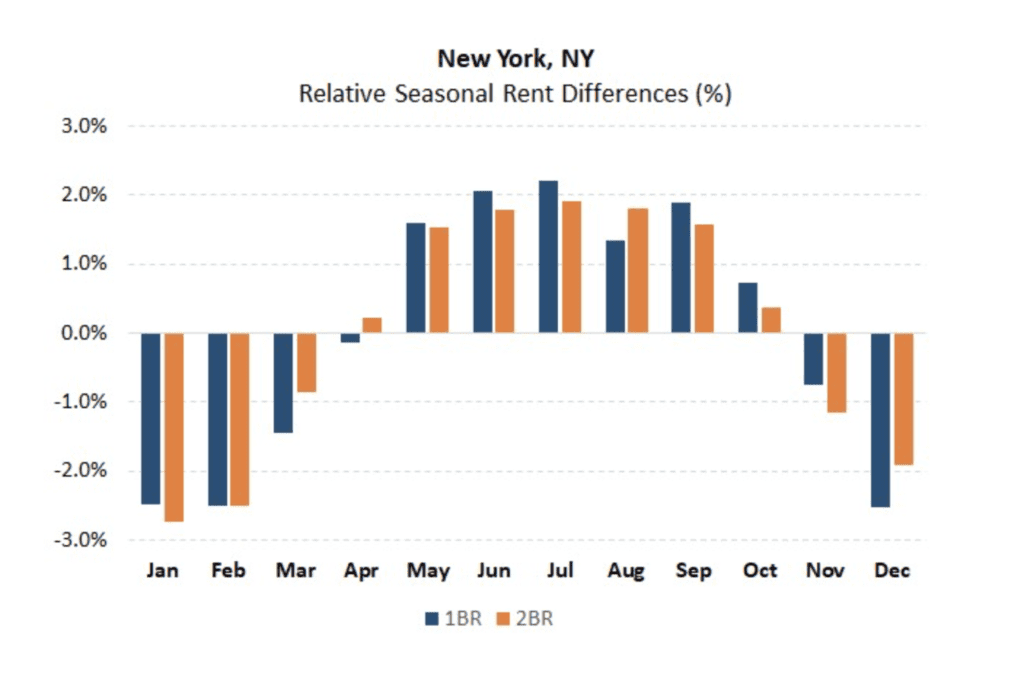
New York City prides itself on being unlike any other. The unique boroughs, the art and music, Broadway — and the rental/real estate market. The good rentals move at lightning speed, and real estate in desirable neighborhoods can be next-to-impossible to come by. And when the high cost of living in NYC is in large part due to housing costs, it literally pays to know the best time of year to move. Moving to a new city is always an adventure of course, and moving to NYC takes the cake. So when is the best time to move to NYC? We’ll break down the factors to consider!

Desirable rental prices in NYC
Let’s be honest, nobody loves the idea of a midwinter moving experience in New York. It’s generally cold, snowy or slushy, and the streets and sidewalks are a mess. But since many, many people feel that way, the majority of moves in New York take place in the warmer months. That means rental prices are more favorable in the winter. According to Renthop.com, renters save an average of 4.7% if they sign a lease in February than if they sign in July. Inventory, however, drops; so if you have really specific criteria, you may find it preferable to move in the spring or autumn shoulder seasons.
Inventory is at its peak in the summer months, with a lot of people moving to NYC for the first time between June and August. That means if you’re quick, you have a much higher chance of finding that specific apartment that you seek. But you do have to move quickly (some call renting in NYC a sport), and the prices will reflect the increased demand. You’re unlikely to see move-in bonuses during these months.
Flexible move-in dates
During the height of summer, rentals and real estate move quickly. That often means your move-in date is probably pretty firm, with zero room to negotiate. After all, if you don’t take the place on that date, someone else will! Landlords may require your lease to begin the day after you sign, which likely doesn’t correspond with the day you’re ready to move in. This can lead to double-paying for your old place and your new one.
In the winter, brokers and landlords want to get their units filled in a market that isn’t moving very quickly. That gives you more leverage to negotiate things like move-in dates and a month or two of free rent. Then, you can set up your moving dates to work in your favor and avoid double-paying and get a good deal on your moving services.

Lower broker’s fees
As of January 2021, New Yorkers still pay (sometimes sky-high) broker’s fees for most rentals. This fee is usually 10-15% of a year’s rent, meaning a pricier apartment in Brooklyn could end up costing thousands of dollars up front in broker fees. And unlike a security deposit, you don’t get that money back.
If you choose to move during the winter, you might be able to negotiate that fee down to a lower sum. If the landlord really wants to fill the unit, they might even pay it! Many landlords and brokers offer incentives to get people to fill their empty units, left over from the summer rush. This probably doesn’t include high-end spots in Manhattan, but then again, nobody’s expecting a discount on a Manhattan apartment.
New York weather
Unfortunately, we can’t list this as one of the benefits of moving in the winter. The weather in NYC can be pretty unpredictable in the winter. It might be blowing snow, or it might be damp and cold. You just never know. If you’re moving to NYC from somewhere warm, you may find the transition a bit of a shock to the system. That right there might be reason enough to steer towards the shoulder season of April-May or September-October, when demand is slightly lower than midsummer.
If you’re still not certain about where to live in New York, have a look at our NYC blog series to get a sense for each borough. Then, let us help you find the right team of movers! Whether you’re moving from LA or Michigan, we can help make your move to NYC smooth and affordable. Get a guaranteed moving quote today!

